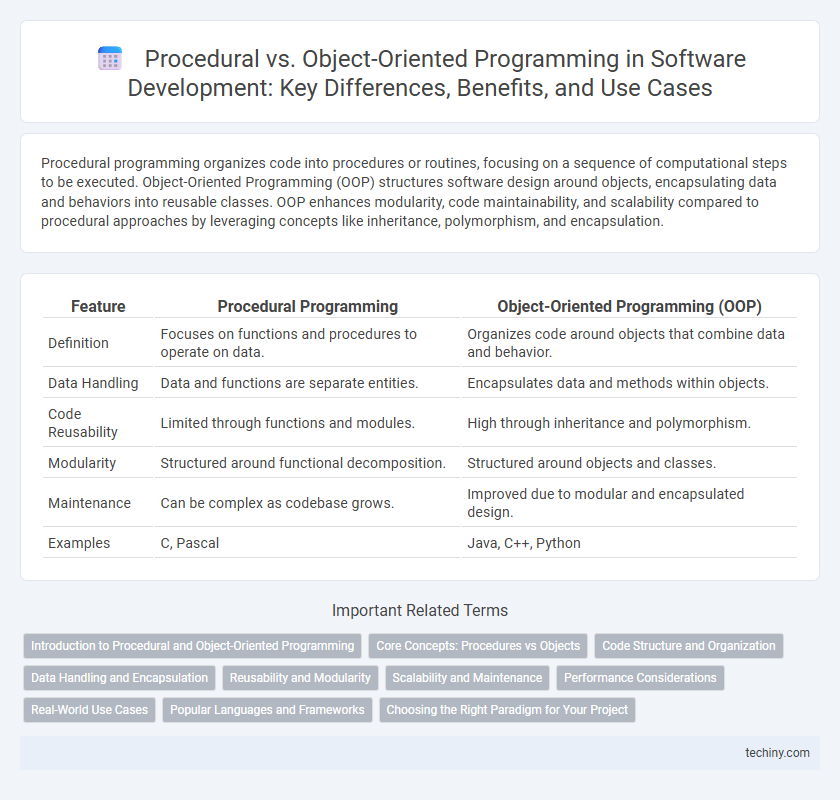Procedural programming organizes code into procedures or routines, focusing on a sequence of computational steps to be executed. Object-Oriented Programming (OOP) structures software design around objects, encapsulating data and behaviors into reusable classes. OOP enhances modularity, code maintainability, and scalability compared to procedural approaches by leveraging concepts like inheritance, polymorphism, and encapsulation.
Table of Comparison
| Feature | Procedural Programming | Object-Oriented Programming (OOP) |
|---|---|---|
| Definition | Focuses on functions and procedures to operate on data. | Organizes code around objects that combine data and behavior. |
| Data Handling | Data and functions are separate entities. | Encapsulates data and methods within objects. |
| Code Reusability | Limited through functions and modules. | High through inheritance and polymorphism. |
| Modularity | Structured around functional decomposition. | Structured around objects and classes. |
| Maintenance | Can be complex as codebase grows. | Improved due to modular and encapsulated design. |
| Examples | C, Pascal | Java, C++, Python |
Introduction to Procedural and Object-Oriented Programming
Procedural programming organizes code into procedures or functions that execute sequentially, emphasizing a step-by-step approach for task completion. Object-oriented programming (OOP) structures code around objects, encapsulating data and behavior into classes that promote reusability and modularity. Understanding the distinctions between procedural and OOP paradigms is crucial for selecting the appropriate methodology to improve code maintainability and scalability in software development projects.
Core Concepts: Procedures vs Objects
Procedural programming organizes code into procedures or functions that perform specific tasks and manipulate data through global variables, emphasizing a linear step-by-step approach. Object-oriented programming centers around objects, which bundle data and methods into encapsulated units, promoting modularity, inheritance, and polymorphism for reusable and scalable code. The core distinction lies in treating procedures as primary building blocks versus objects that combine state and behavior.
Code Structure and Organization
Procedural programming organizes code into linear sequences of functions and procedures that operate on data, promoting straightforward execution flow but often leading to fragmented code management. Object-oriented programming structures code around objects and classes, encapsulating data and behavior, which enhances modularity, reusability, and maintenance. This paradigm supports inheritance and polymorphism, resulting in more scalable and organized software systems compared to the procedural approach.
Data Handling and Encapsulation
Procedural programming handles data through procedures or functions where data is passed explicitly, lacking inherent protection from unauthorized access, which can lead to less secure and harder-to-maintain code. Object-oriented programming encapsulates data within objects, bundling it with methods that control access and modification, promoting data integrity and reusable, modular code. This encapsulation in OOP enhances security by restricting direct data manipulation, improving maintainability compared to procedural approaches.
Reusability and Modularity
Procedural programming organizes code into reusable functions, enabling modular development but often lacks the encapsulation needed for complex systems. Object-oriented programming enhances reusability and modularity by bundling data and behavior into objects, promoting inheritance and polymorphism for efficient code extension and maintenance. This encapsulation reduces dependencies and improves code scalability in large software projects.
Scalability and Maintenance
Procedural programming structures code in a linear, step-by-step manner, which can limit scalability and complicate maintenance as projects grow. Object-oriented programming (OOP) enhances scalability by encapsulating data and behaviors into reusable classes, promoting modularity and easier code management. Maintenance becomes more efficient in OOP due to inheritance and polymorphism, allowing developers to update or extend functionality without extensive code rewrites.
Performance Considerations
Procedural programming often exhibits faster execution times due to its straightforward, linear code structure and lower overhead in function calls, making it ideal for performance-critical applications. Object-oriented programming introduces abstraction layers like classes and objects, which can incur additional memory usage and slower method dispatch, impacting runtime efficiency. Optimizing performance in OOP requires careful management of object lifecycles and minimizing polymorphism overhead while leveraging procedural techniques within methods when necessary.
Real-World Use Cases
Procedural programming excels in tasks requiring straightforward, linear execution such as scripting, data processing, and system-level programming where performance and simplicity are crucial. Object-oriented programming dominates complex applications like game development, GUI design, and large-scale software systems by promoting modularity, code reuse, and easier maintenance through encapsulation and inheritance. Real-world software often blends both paradigms to leverage procedural efficiency in critical sections while using object-oriented structures for scalability and organization.
Popular Languages and Frameworks
Procedural programming languages such as C and Pascal emphasize linear step-by-step instructions, making them suitable for straightforward tasks and system-level programming. Object-oriented languages like Java, C++, and Python support encapsulation, inheritance, and polymorphism, enabling modular and reusable code structures commonly utilized in frameworks like Spring, Django, and Qt. Popular frameworks aligned with object-oriented paradigms facilitate complex application development by organizing code into interacting objects rather than simple procedures.
Choosing the Right Paradigm for Your Project
Choosing between procedural and object-oriented programming depends on project complexity, scalability needs, and team expertise. Procedural programming suits straightforward tasks with linear workflows, while object-oriented programming excels in managing complex systems through modularity and reusability. Evaluating project requirements and future maintenance considerations helps determine the most effective paradigm for sustainable software development.
Procedural vs Object-Oriented Infographic

 techiny.com
techiny.com